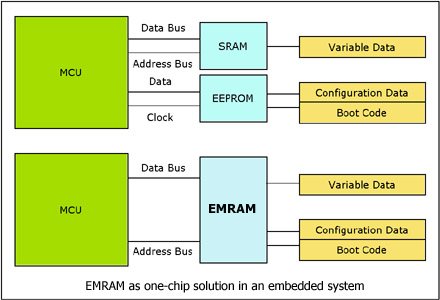|
 |
Most MCUs (microcontrollers) are not equipped with
sufficient RAM space for execution. The common alternatives are all
sub-optimal: either upgrade to a microcontroller with higher density
embedded RAM at a significant premium, or go with an external serial EEPROM
with limited write endurance and serial access. |
|
MCU |
RAID
|
RFID
|
Smart Card
|
SRAM Replacement
|
|
|
EMRAM Extension of MCU
EMRAM is a fast memory (cycle time <70ns), is nonvolatile and
has unlimited write / read endurance. It is in effect RAM and nonvolatile
storage in the same device. Because of this unique combination, EMRAM is a
perfect choice as the external supplemental memory to a MCU. The user can
decide on the segmentation of volatile and nonvolatile data within a single
EMRAM device. To further optimize the performance of the MCU-EMRAM
combination, the user can assign variables that require high speed and
frequent access to the embedded RAM.
This document outlines some key memory considerations facing
the user today, and how EMRAM can be integrated into the system.
Memory Applications
As a RAM-extension of the MCU, EMRAM can be
used in all of the following memory applications:

Sample Storage
This is the place where the software collects data for later processing.
This is a write intensive application with high data-sample rate that
rapidly accumulates write cycles. In certain applications, data is not
collected at sufficiently high rate because of the bottleneck in memory
speed.
EEPROM is not suitable for data storage because of poor
write endurance (100,000-1,000,000 write cycles), slow write time (~10ms)
and high write power (12V). EMRAM overcomes all this. It has unlimited write
endurance, writes with no delay and consumes little power (write voltage
5V).
In an Analog/Digital conversion, EMRAM easily supports data
sampling at less than 1 µs
interval (1MHz) for continuous operation at 365 days / 24 hours while EEPROM
and other memory alternatives cannot.
Scratchpad Buffer
This is a general purpose memory block that is subject to random write
operations. Endurance over long periods is unpredictable and is therefore a
key consideration. Because write operations is essentially random, the user
do not want to employ a memory with a limited endurance performance. As
EMRAM
has unlimited write endurance, it is well suited to even the most demanding
scratch pad buffer needs.
Circular Buffer
This is a memory block where software uses each memory location in sequence
until it reaches the end of the block before starting at the beginning of
the address range. The write operations normally occur periodically and with
a fixed buffer size. It is therefore the least demanding application in
terms of endurance performance.
Microcontroller Interface
In a system that already employs an external
EEPROM to a MCU, adding EMRAM requires simply a replacement of the EEPROM
with a pin-compatible serial EMRAM with the desired memory density. Write
data to new memory locations as though the serial device is a RAM. When a MCU does not support serial RAM, the user application must move data from
EMRAM to the embedded RAM locations before execution.The user will also have
to modify the system to take advantage of EMRAM’s higher speed by acknowledge
polling and removing any delays.
In a system that does not currently use external EEPROM, the
EMRAM device must be designed in. Because EMRAM is available in both serial
(I2C, Microwire, SPI) and parallel (RAM) formats, it should be compatible
with existing MCU interfaces and direct connection is possible. If software
emulation of the interface is required, the user can obtain the appropriate
software from major MCU vendors who maintain a large library of such
software.
Information
furnished is believed to be accurate and reliable. However, NLSC assumes no
responsibility for the consequences of use of such information nor for any
infringement of patents or other rights of third parties which may result
from its use. No license is granted by implication or otherwise under any
patent or patent rights of NLSC. Specifications mentioned in this
publication are subject to change without notice. This publication
supercedes and replaces all information previously supplied. NLSC products
are not authorized for use as critical components in life support devices or
systems without express written approval of NLSC.
© 2004 Northern
Lights Semiconductor Corp – All Rights Reserved
www.nlsemi.com
|
|

